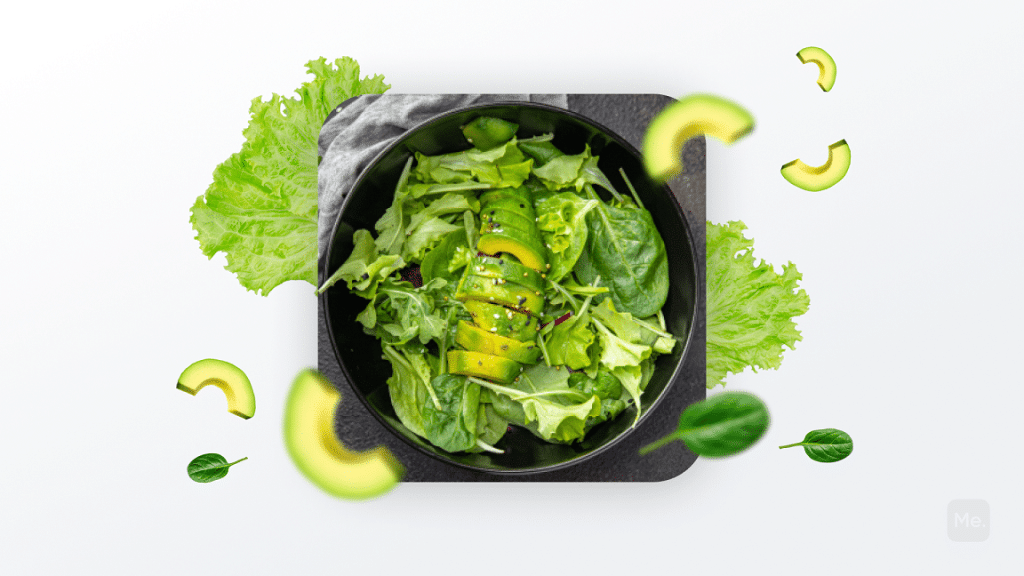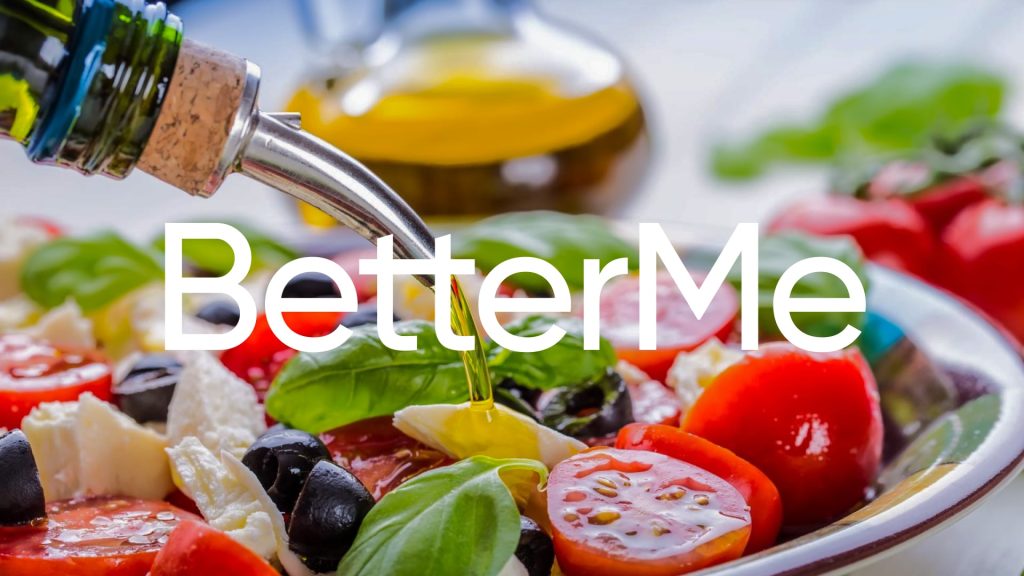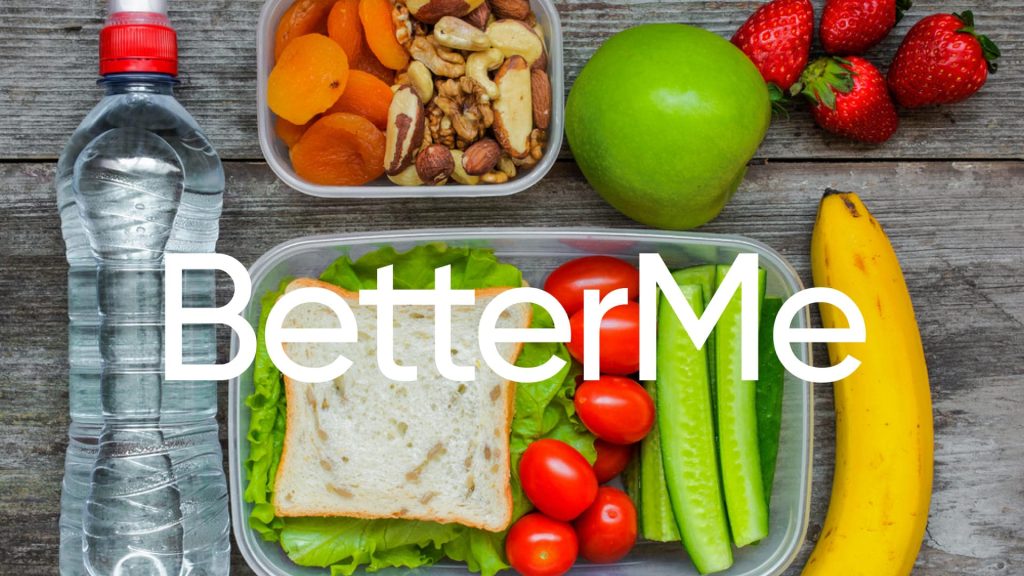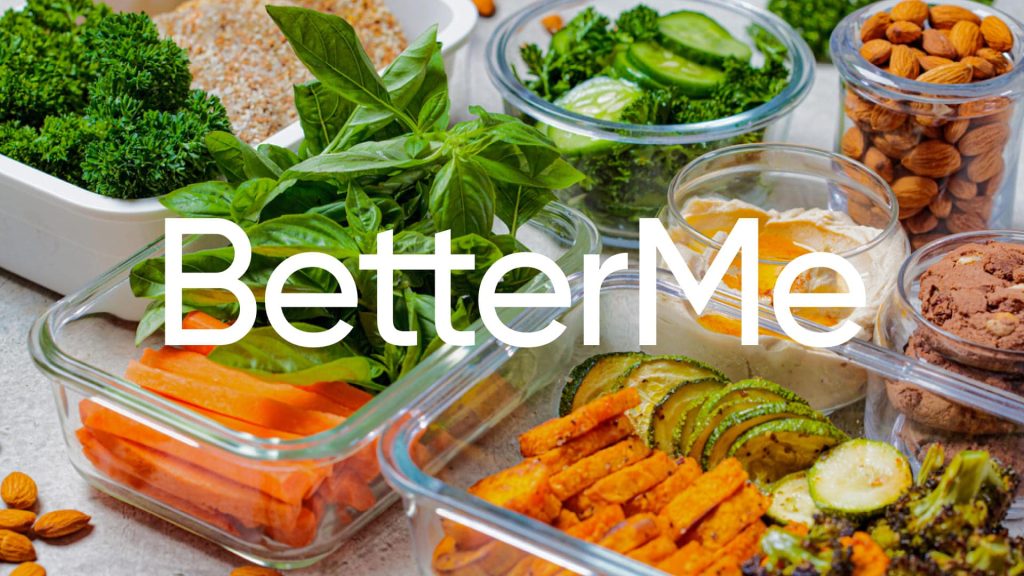According to the CDC, powerhouse fruits and vegetables are the best fruits and vegetables to eat daily. They contain the 17 nutrients of public health importance as per the Food and Agriculture Organization of the United Nations and Institute of Medicine. These 17 nutrients include vitamins A, B6, B12, C, D, E, K, calcium, fiber, folate, iron, niacin, potassium, protein, riboflavin, thiamin, and zinc.
Get your personalized
meal plan!
The powerhouse vegetables we shall discuss below, including cruciferous, leafy greens, yellow-orange, and allium vegetables, are the best vegetables to eat daily because they’re strongly associated with a risk reduction for chronic diseases and cancer obesity, among other health conditions.
1. Cruciferous Vegetables
Cruciferous vegetables are veggies in the Brassicaceae/Cruciferae family and part of the Brassica genus. They include cauliflower, cabbage, kale, bok choy, broccoli, Brussel sprouts, garden cress, arugula, watercress, wasabi, collard greens, kohlrabi, rutabaga, green turnips, among other leafy vegetables (21).
However, they contain varying nutritional profiles in that kale and broccoli have higher beta-carotene, lutein, and zeaxanthin than cauliflower, for example. Cruciferous vegetables in general are excellent fiber sources and dense in nutrients. According to the National Cancer Institute, they contain carotenoids such as lutein, beta-carotene, and zeaxanthin; vitamins such as C, E, and K; folate; and minerals.
Cruciferous vegetables are one of the best vegetables to eat daily because they are great in the fight and prevention of cancer since they contain sulfuric chemicals called glucosinolates. Glucosinolates give the vegetables their sour/bitter tastes. Upon digestion, they form biologically active compounds such as indoles, nitriles, thiocyanates, and isothiocyanates, which have anti-cancer properties (40).
Studies in animals revealed that these active compounds could inhibit cancer development in multiple organs, including the lung, stomach, colon, breast, liver, and bladder (25). Additionally, these compounds can also aid to protect DNA damage in cells, inactivate carcinogens, induce cell death, and inhibit tumor blood vessel formation (12).
Another study on humans revealed that glucosinolates and their hydrolysis products such as isothiocyanates and indoles may lower lung and colorectal cancer risks (14).
Read More: Benefits Of Super Greens: 11 Reasons To Include Them In Your Diet
2. Green Leafy Vegetables
Leafy vegetables also referred to as salad greens, pot herbs, or plant leaves, have the highest dietary source of vitamin K (phylloquinone) because of their green coloring pigment. These salad greens are the best raw vegetables to eat daily and are in a variety, including lettuce (romaine and iceberg), spinach, collard greens, beet greens, Swiss chard, kale, endive, chicory, fennel, moringa, bok choy, and other green vegetables.
Leafy vegetables are low in calories and fat but high in dietary fiber, calcium, magnesium, potassium, phosphorus, sodium, vitamin A, C, K, beta-carotene, lutein, and zeaxanthin. Again, they contain some nutritional differences, such as vitamin k, folate, and calcium content in lettuce is lower than in spinach and kale.
Despite this, leafy greens carry plenty of phytochemicals such as beta-carotene, which helps to reduce the risk of cancer and cardiovascular diseases. In addition, because of their high magnesium and fiber content and low glycemic index, these greens are also beneficial to individuals with type 2 diabetes (22).
Additionally, these vegetables contain high polyphenols and antioxidants, which have antimicrobial, anticancer, and anti-inflammatory properties (22).
Research shows that foods high in lutein and zeaxanthin carotenoids, such as green leafy vegetables, may help reduce the risk of coronary heart disease and stroke (42). Additionally, they could offer protection against skin swelling (edema) and hyperplasia caused by UV exposure of the skin (16).
In summary, leafy greens offer many health benefits, including the mitigated risk of obesity, high blood pressure, obesity, and mental decline (31).
3. Yellow/ Orange Vegetables
The third type of powerhouse veggies is yellow-orange and red vegetables. These veggies include tomato, carrots, butternut, squash, sweet potatoes, pumpkins, sweetcorn, red/orange and yellow bell peppers, tomatoes, swede, kumara, yams, and yellow beets.
Carrots and squash are low in calories but high in calcium, potassium, choline, vitamin A, and alpha and beta carotene. Squash, pumpkin, and butternut are high in calories and fiber, vitamin A, choline, potassium, sodium, and beta-carotene. Because of the high fiber content in squash and pumpkin, they are the best vegetables to eat daily for weight loss since they contain essential nutrients and enough fiber and energy to last long hours.
Health Benefits
Even with the different nutritional values, yellow-orange vegetables are equally high in antioxidants, precisely carotenoids, giving them the yellow-orange hue. They also contain good enough fiber, vitamin C, K, zeaxanthin, flavonoids, and lycopene (23).
-
Improved Eye Health
The most significant health benefit of yellow-orange vegetables is improved eye health. Veggies like carrots and tomatoes contain the highest dietary source of lutein and zeaxanthin carotenoids, which play a significant role in eye health (17). Epidemiological studies reveal that these two carotenoids constitute the primary pigment in the human retina which protects the macula from damage by blue light, improves visual acuity, and scavenge harmful reactive oxygen species (17).
The study also shows a link between the carotenoids and reduced risk of cataracts and age-related macular degeneration (AMD).
BetterMe will keep you laser-focused on your weight loss journey! Nutrient-packed meal plans, fat-blasting workouts, galvanizing challenges and much more. Try using the app and see for yourself!
-
Reduced Cancer Risk
Yellow-orange vegetables contain high levels of beta-carotene and other antioxidants such as lycopene, lutein, zeaxanthin, and alpha-carotene. The lycopene found in tomatoes, pawpaw, and other fruits has anticancer properties in that it has antioxidant activity, induces the cell to cell communications and growth control (29).
-
Lower Blood Pressure
Potassium and sodium are electrolytes that help your body maintain fluid and blood volume. If your body lacks these electrolytes, your blood pressure may rise. Yellow-orange vegetables are high in both potassium and sodium (34).
-
Other Benefits
Because of their high nutrient content, they also have other benefits, including.
- Healthy Teeth and Gums. Orange vegetables are high in vitamin A which is essential in salivary glands’ function. Deficiency in vitamin A can cause salivary glands atrophy and enamel hypoplasia (30).
- High levels of vitamin C can also help prevent gingivitis/ bleeding gums.
- Healthy bones and joints thanks to their high calcium and magnesium mineral content.
- May lower low density lipoprotein cholesterol in the body (24).
4. Allium Vegetables
Allium vegetables are bulb-like veggies such as garlic, onion, scallions, leeks, chives, and shallots. They’re not as nutrient-dense as green leafy and orange vegetables, but they have their share of nutrients. Garlic is nutritionally more dense than the other alliums with additional minerals like selenium, but onions contain higher carbs, potassium, fiber, iron, and vitamin C.
Health Benefits
Allium veggies contain many bioactive compounds such as arginine, oligosaccharides, flavonoids, organosulfur compounds like quercetin and saponins. These compounds offer you anti-inflammatory, anticancer, antiobesity, antidiabetic, antioxidant, and antimicrobial properties (41).
-
Prevents Cancer
Some studies show that allium vegetables may help prevent cancer, especially gastrointestinal tract cancers, including gastric, colorectal, and esophageal cancers (20). However, the results can vary because of multiple factors like genetics, vegetable preparation, and dietary components.
Epidemiological studies also have revealed that allium vegetables could potentially reduce the risk of prostate cancer thanks to their rich content in flavonoids and organosulfur compounds, which have tumor inhibitory effects (3).
Read More: What Is A Serving Of Vegetables? How To Get Your Portions Right According To Science
-
Kills Bacteria and Fungi
Garlic contains allicin, an active component with broad-spectrum antimicrobial activity against many bacteria and fungi. Studies show that this extract can inhibit various Gram-negative and Gram-positive bacteria and serve as antifungal agents (1). Moreover, additional compounds such as DAS, DADS, and ajoene derivatives can also add to garlic antimicrobial activities.
Another study revealed that garlic extract could inhibit the bacterial effects of Helicobacter pylori, which is linked to gastritis and gastric cancer (26). Heating the garlic extract reduced its efficacy, however.
-
Promotes Gut Health
Onions and garlic contain rich soluble fibers called fructans which aid in promoting healthy gut bacteria. The fructans support a healthy microbiome by providing prebiotic fuel for the human intestinal microflora (38).
-
Additional Benefits
Allium vegetables also have other possible benefits such as improved metabolic activity, reduced blood pressure, and a lower risk of cardiovascular diseases (2). Additionally, quercetin, which is the leading flavonoid in allium vegetables, also offers many other potential benefits, including (43):
- Fighting free radicals
- Preventing neurological diseases
- Relieving allergy symptoms
- Preventing infections
Lastly, garlic contains thiocremonone, which is an organosulfur compound with anti-inflammatory properties. Studies show that thiocremonone is a valuable agent for treating inflammation and arthritic diseases (4).
4. Berry Fruits
Berry fruits like strawberries, cranberries, blueberries, and chokeberries are not vegetables but are part of the powerhouse fruits and vegetables. Much like the power veggies, they’re essential in the body because they’re low in calories and high in fiber, moisture, folic acid, calcium, selenium, alpha and beta carotene, lutein, and vitamins C and E.
Berry fruits contain phytochemicals such as polyphenols and flavonoids like ellagitannins and anthocyanins, which may help to reduce the risks for cancers, neurodegenerative, and cardiovascular diseases. Studies show that berries may be able to improve one’s cardiovascular risk profiles through improving lipid peroxidation, dyslipidemia, LDL oxidation, glucose metabolism, and total plasma antioxidant capacity (5, 33).
Conclusion
Powerhouse fruits and vegetables are healthy foods that contain high amounts of nutrients essential for good health and effective body function. As you’ve learned from the article, the best vegetables to eat daily include cruciferous vegetables, leafy greens, yellow-orange vegetables, and allium vegetables, without forgetting berries.
DISCLAIMER:
This article is intended for general informational purposes only and does not address individual circumstances. It is not a substitute for professional advice or help and should not be relied on to make decisions of any kind. A licensed physician should be consulted for the diagnosis and treatment of any medical conditions. Any action you take upon the information presented in this article is strictly at your own risk and responsibility!
SOURCES:
- Allium sativum (garlic)-a natural antibiotic (1983, pubmed.Nih.gov)
- Allium vegetable consumption and health (2019, ncbi.nlm.nih.gov)
- Allium Vegetables and Risk of Prostate Cancer (2002,academic.oup.com)
- Anti-inflammatory and arthritic effects of thiacremonone, a novel sulfur compound isolated from garlic via inhibition of NF-κB (2009, biomedcentral.com)
- Berries: emerging impact on cardiovascular health (2011, ncbi.nlm.nih.gov)
- Blueberry (n.d., usda.gov)
- Broccoli (n.d., usda.gov)
- Brussel sprouts (n.d., usda.gov)
- Carrots (n.d., usda.gov)
- Cauliflower (n.d., usda.gov)
- Chives (n.d., usda.gov)
- Cruciferous vegetables and cancer prevention (2001, pubmed.Nih.gov)
- Cruciferous Vegetables and Cancer Prevention (2012, cancer.gov)
- Cruciferous vegetables and human cancer risk (2007, pubmed.Nih.gov)
- Defining Powerhouse Fruits and Vegetables (2014, cdc.gov)
- Dietary lutein/zeaxanthin decreases ultraviolet B-induced epidermal hyperproliferation and acute inflammation in hairless mice (2003, pubmed.Nih.gov)
- Dietary sources of lutein and zeaxanthin carotenoids and their role in eye health (2013, pubmed.Nih.gov)
- Functional foods and their role in cancer prevention and health promotion (2017, ncbi.nlm.nih.gov)
- Garlic (n.d., usda.gov)
- Garlic and onions: Their cancer prevention properties (2016, ncbi.nlm.nih.gov)
- Glucosinolates in cruciferous vegetables (n.d., usda.gov)
- Green leafy vegetables (2015, Sciencedirect.com)
- Health benefits of red and orange vegetables (2020, WebMD.com)
- Hypocholesterolemic effect of lycopene and beta-carotene is related to the suppression of cholesterol synthesis and augmentation of LDL receptor activity in macrophages (1997, pubmed.Nih.gov)
- Inhibition of carcinogenesis by isothiocyanates (2000, pubmed.Nih.gov)
- Inhibition of Helicobacter pylori by garlic extract (Allium sativum) (1996, pubmed.Nih.gov)
- Kale (n.d., usda.gov)
- Lettuce (n.d., usda.gov)
- Lycopene: a biologically important carotenoid for humans (1996, pubmed.Nih.gov)
- Malnutrition and its Oral Outcome (2013, ncbi.nlm.nih.gov)
- Nutrients and bioactives in green leafy vegetables and cognitive decline (2018, pubmed.Nih.gov)
- Onion (n.d., usda.gov)
- Recent trends and advances in berry health benefits research (2010, pubmed.ncbi.nlm.nih.gov)
- Role of potassium and sodium in your diet (2021, cdc.gov)
- Spinach (n.d., usda.gov)
- Squash (n.d., usda.gov)
- Strawberry (n.d., usda.gov)
- Study on prebiotic effectiveness of garlic frutan (2013, Sciencedirect.com)
- Sweet potato (n.d., usda.gov)
- The cancer chemopreventive actions of phytochemicals derived from glucosinolates (2008, pubmed.Nih.gov)
- Therapeutic Role of Functional Components in Alliums for Preventive Chronic Disease in Human Being (2017, hindawi.com)
- The science behind lutein (2004, pubmed.Nih.gov)
- What are the benefits of quercetin? (2019, medicalnewstoday.com)














